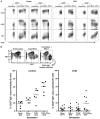Toll-like receptor 7 and 9 defects in common variable immunodeficiency
- PMID: 19592080
- PMCID: PMC2908501
- DOI: 10.1016/j.jaci.2009.05.019
Toll-like receptor 7 and 9 defects in common variable immunodeficiency
Abstract
Background: Common variable immunodeficiency (CVID) is characterized by hypogammaglobulinemia, reduced numbers of peripheral blood isotype-switched memory B cells, and loss of plasma cells.
Objective: Because Toll-like receptor (TLR) activation of B cells can initiate and potentially sustain normal B cell functions, we examined functional outcomes of TLR7 and TLR9 signaling in CVID B cells.
Methods: TLR7-mediated, TLR7/8-mediated, and TLR9-mediated cell proliferation, isotype switch, and immunoglobulin production by control and CVID B cells or isolated naive and memory B cell subsets were examined. We quantitated TNF-alpha, IL-6, and IL-12 production in response to TLR1-9 ligands and measured IFN-alpha production by TLR7-stimulated PBMCs and isolated plasmacytoid dendritic cells (pDCs). IFN-beta mRNA expression by TLR3-stimulated fibroblasts was assessed.
Results: Unlike CD27(+) B cells of controls, TLR7-activated, TLR7/8-activated, or TLR9-activated CVID B cells or isolated CD27(+) B cells did not proliferate, upregulate CD27, or shed surface IgD. TLR-stimulated CVID B cells failed to upregulate activation-induced cytosine deaminase mRNA or produce IgG and IgA. TLR7-stimulated PBMCs and pDCs produced little or no IFN-alpha. Reconstituting IFN-alpha in TLR7-stimulated CVID B-cell cultures facilitated proliferation, CD27 upregulation, and isotype switch. These TLR defects are restricted because CVID PBMCs stimulated with TLR ligands produced normal amounts of TNF-alpha, IL-6, and IL-12; TLR3-mediated expression of IFN-beta by CVID fibroblasts was normal.
Conclusion: Defective TLR7 and TLR9 signaling in CVID B cells and pDCs, coupled with deficient IFN-alpha, impairs CVID B cell functions and prevents TLR-mediated augmentation of humoral immunity in vivo.
Conflict of interest statement
Disclosure of potential conflict of interest: C. Cunningham-Rundles is a medical advisor for Talecris and Baxter and receives grant support from the National Institutes of Health. A. K. Knight receives research support from Genentech, AstraZeneca, Novartis, Wyeth, Schering-Plough, UCB Inc, and GlaxoSmithKline. The rest of the authors have declared that they have no conflict of interest.
Figures






References
-
- Grimbacher B, Hutloff A, Schlesier M, Glocker E, Warnatz K, Drager R, et al. Homozygous loss of ICOS is associated with adult-onset common variable immunodeficiency. Nat Immunol. 2003;4:261–8. - PubMed
-
- Goldacker S, Warnatz K. Tackling the heterogeneity of CVID. Curr Opin Allergy Clin Immunol. 2005;5:504–9. - PubMed
-
- van Zelm MC, Reisli I, van der Burg M, Castano D, van Noesel CJ, van Tol MJ, et al. An antibody-deficiency syndrome due to mutations in the CD19 gene. N Engl J Med. 2006;354:1901–12. - PubMed
-
- Salzer U, Chapel HM, Webster AD, Pan-Hammarstrom Q, Schmitt-Graeff A, Schlesier M, et al. Mutations in TNFRSF13B encoding TACI are associated with common variable immunodeficiency in humans. Nat Genet. 2005;37:820–8. - PubMed
-
- Castigli E, Wilson SA, Garibyan L, Rachid R, Bonilla F, Schneider L, et al. TACI is mutant in common variable immunodeficiency and IgA deficiency. Nat Genet. 2005;37:829–34. - PubMed
Publication types
MeSH terms
Substances
Grants and funding
LinkOut - more resources
Full Text Sources
Research Materials
Miscellaneous

